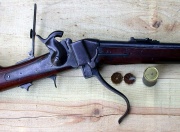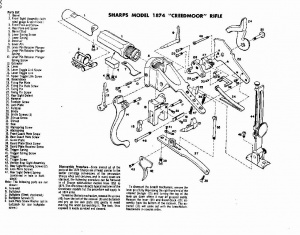Sharps rifle
| Sharps rifle | |
|---|---|

| |
|
| |
| Type | rifle / carbine |
| Land of Origin | United States |
| Specifications | |
| Length | 47 inches (1,200 mm) |
| Weight | 9.5 lb (4.3 kg) |
| Cartridge | Originally a .52-caliber 475-grain projectile with 50-grain (3.2 g) cartridge; later converted to .45-70 Government in 1873. |
| Action | Falling Block |
|
| |
| Rate of Fire | 8–10 shots/minute |
| Muzzle velocity | 1,200 ft/s (370 m/s) |
| Effective Range | 500 yd (460 m) |
| Max. Range | 1,000 yd (910 m) |
| Sights | open ladder |
| Service History | |
| In service | 1850–1881 |
| Used by | Union Army, Confederate Army |
| Wars | American Civil War |
| Production History | |
| Designer | Christian Sharps |
| Design Date | 1848 |
| Manufacturer | A. S. Nippes, Robbins & Lawrence Company, Sharps Rifle Manufacturing Company, many others |
| No. Built | over 100,000 |
| Variants | also produced as a carbine |
Literally dozens of reproductions of the Sharps rifle are currently made by different rifle companies and have become an icon of the Old West by their use in a number of Western movies.
Contents[hide] |
[edit] History
Sharps' initial rifle was patented September 17, 1848[1] and manufactured by A. S. Nippes at Mill Creek, (Philadelphia) Pennsylvania.
The second model used the Maynard tape primer, and surviving examples are marked Edward Maynard - Patentee 1845. In 1850 the second model was brought to the Robbins & Lawrence Company of Windsor, Vermont where the Model 1851 was developed for mass production. Rollin White of the R&L Co. invented the knife-edge breech block and self-cocking device for the "box-lock" Model 1851. This is referred to as the "First Contract", which was for 5,000 Model 1851 carbines - of which approximately 1,650 were produced by R&L in Windsor.
In 1851 the "Second Contract" was made for 15,000 rifles and the Sharps Rifle Manufacturing Company was organized as a holding company with $1,000 in capital and with John C. Palmer as president, Christian Sharps as engineer, and Richard S. Lawrence as master armorer and superintendent of manufacturing. Sharps was to be paid a royalty of $1 per firearm and the factory was built on R&L's property in Hartford, Connecticut.
The Model 1851 was replaced in production by the Model 1853. All Sharps rifles were manufactured in Windsor until October 1856. Christian Sharps left the company in 1853; Richard S. Lawrence continued as the chief armorer until 1872 and developed the various Sharp models and their improvements that made the rifle famous.
The 1874-pattern Sharps was a particularly popular rifle that led to the introduction of several derivatives in quick succession. It handled a large number of .40- to .50-caliber cartridges in a variety of loadings and barrel lengths.[2][3]
Hugo Borchardt designed the Sharps-Borchardt Model 1878, the last rifle made by the Sharps Rifle Co. before its closing in 1881.
Reproductions of the paper cartridge Sharps M1859 and M1863 Rifle and Carbine, the metallic cartridge 1874 Sharps Rifle, and Sharps-Borchardt Model 1878 are being manufactured today. They are used in Civil War re-enacting, hunting and target shooting.
[edit] Sharps military rifles and carbines
The military Sharps rifle (also known as the Berdan Sharps rifle) was a falling block rifle used during and after the American Civil War.[4] Along with being able to use a standard percussion cap, the Sharps had a fairly unusual pellet primer feed. This was a device which held a stack of pelleted primers and flipped one over the nipple each time the trigger was pulled and the hammer fell - making it much easier to fire a Sharps from horseback than a gun employing individually loaded percussion caps.The Sharps Rifle was produced by the Sharps Rifle Manufacturing Company in Hartford, Connecticut. It was used in the Civil War by the U.S. Army Marksman, known popularly as "Berdan's Sharpshooters" in honor of their leader Hiram Berdan. The Sharps made a superior sniper weapon of greater accuracy than the more commonly issued muzzle-loading rifled muskets. This was due mainly to the higher rate of fire of the breech loading mechanism and superior quality of manufacture.
At this time however, many officers were distrustful of breech-loading weapons on the grounds that they would encourage men to waste ammunition. In addition, the Sharps Rifle was expensive to manufacture (three times the cost of a muzzle-loading Springfield rifle) and so only 11,000 of the Model 1859s were produced. Most were unissued or given to sharpshooters, but the 13th Pennsylvania Reserves (which still carried the old-fashioned designation of a "rifle regiment") carried them until being mustered out in 1864.
[edit] Sharps military carbine

The carbine version was very popular with the cavalry of both the Union and Confederate armies and was issued in much larger numbers than the full length rifle. The falling block action lent itself to conversion to the new metallic cartridges developed in the late 1860s, and many of these converted carbines in .50-70 Government were used during the Indian Wars in the decades immediately following the Civil War.[4]
Some Civil War-issue carbines had an unusual feature: a coffee mill in the stock.[5]
Unlike the Sharps rifle, the carbine was very popular and almost 90,000 were produced. By 1863, it was the most common weapon carried by Union cavalry regiments, although in 1864 many were replaced by 7-shot Spencer carbines. Some Sharps clones were produced by the Confederates in Richmond. Quality was generally poorer and they normally used brass fittings instead of iron.
[edit] Sharps sporting rifles
Sharps made sporting versions from the late 1840s until the late 1880s. After the American Civil War, converted Army surplus rifles were made into custom firearms, and the Sharps factory produced Models 1869 and 1874 in large numbers for commercial buffalo hunters and frontiersmen. These large-bore rifles were manufactured with some of the most powerful black powder cartridges ever made. Sharps also fabricated special long-range target versions for the then-popular Creedmore style of 1,000-yard (910 m) target shooting. Many modern black powder cartridge silhouette shooters use original and replica Sharps rifles to target metallic silhouettes cut in the shapes of animals at ranges up to 500 meters. Shiloh Rifle Manufacturing Company, and C Sharps Arms of Big Timber, Montana, have been manufacturing reproductions of the Sharps Rifle since 1983 and 1979, respectively.
[edit] In film
Some movies which showed the strengths of the Sharps rifle are Billy Two Hats (1974), Rancho Deluxe (1975), Valdez Is Coming (1971), Quigley Down Under (1990), True Grit (the 2010 version). In the 1990 western Quigley Down Under Tom Selleck's title character's Sharps rifle has a 34" barrel as opposed to a standard length barrel of 30" and Burt Lancaster's character, Bob Valdez, in the movie Valdez Is Coming.[6]
As a result of Quigley Down Under a Sharps match is held annually every year in Forsyth, Montana known as the "Quigley Match". A 44-inch target is placed at 1,000 yards for each shooter, reminiscent of a scene from the movie.[7] Theater Crafts Industry went so far as to say, "In Quigley Down Under, which we did in 1990, the Sharps rifle practically co-stars with Tom Selleck."[8] This statement was echoed by gunwriters including John Taffin in Guns and Lionel Atwill in Field & Stream.[6][9] Gun manufacturers such as Davide Pedersoli and Shiloh Rifle Manufacturing Company have credited these movies with an increase in demand for those rifles.[6]
The Sharps carbine is also seen in the 2010 remake of True Grit, used by Matt Damon's character LaBoeuf. During the course of the film, the carbine's accuracy becomes a source of debate between LaBoeuf and "Rooster" Cogburn; at the film's conclusion, the accuracy of the gun is validated.
[edit] Resources

This article has no links to any manuals whatsoever! This article needs more input to fill in those missing bits. You (yes, you!) can help Gunsopedia provide more comprehensive information to our users by submitting a manual that you might have. See this page to find out how you can contribute a manual to the Gun Owners' Resource Online Library and help your fellow gun owners. With your help, we really can make this a one-stop resource for all gun owners!
[edit] See also
- .50-90 Sharps
- Beecher's Bibles
- Berdan rifle
- List of American military firearms
- Spencer rifle
- Listing of Sharps rifles in movies at the IMDB.
[edit] Notes
- ↑ Patent number RE1720, "Improvement in Beech-loading Fire-arms". Issue date: July 5, 1864.
- ↑ The Guns that Won the West: Firearms of the American Frontier: 1848-1898, John Walter, 2006, p. 129-133
- ↑ Guns of the Old West, Dean Boorman, 2004, p. 44-47
- ↑ 4.0 4.1 Hogg, Ian V.(1987) Weapons of the Civil War. New York: Military Press, ISBN 0-517-63606-9.
- ↑ Strategy Page accessed 13 June 2011
- ↑ 6.0 6.1 6.2 Taffin, John (1994). "The Sharps 1874". Guns Magazine (Harris) 41 (5): 60–63. "That movie has done for the Sharps rifle what Dirty Harry did for the Smith & Wesson .44 Magnum back in the 1970's."
- ↑ Van Zwoll, Wayne (2008). Hunter's Guide to Long-Range Shooting. Stackpole Books. pp. 27–28. ISBN 978-0-8117-3314-4.
- ↑ TCI: the business of entertainment technology & design, Volume 29(1995)
- ↑ Atwill, Lionel (1997). "The Return of the Buffalo Gun". Field & Stream 102 (9): 50–53. "In truth Tom Selleck must share credit with the movie's real stars; Quigley's .45-110 Sharps"
[edit] References
- Coates, Earl J., and Thomas S. Dean. An Introduction to Civil War Small Arms. Gettysburg, Penn.: Thomas Publications, 1990. ISBN 0-939631-25-3.
- Sellers, Frank M. Sharps Firearms. North Hollywood, Calif: Beinfeld Pub, 1978. ISBN 0-917714-12-1.
- Smith, Winston O. The Sharps Rifle, Its History, Development and Operation. New York: W. Morrow & Company, 1943.
[edit] External links
- Sharps Model 1874 - Background history
- Sharps Model 1874 - Shooting and reloading
- http://shilohrifle.com/
- Firearms
- Pages missing manuals
- American firearms
- .45-70 firearms
- Falling block firearms
- Rifles
- American .45-70 firearms
- American falling block firearms
- American rifles
- .45-70 falling block firearms
- .45-70 rifles
- Falling block rifles
- Single shot rifles
- American .45-70 falling block firearms
- American .45-70 rifles
- American falling block rifles
- American single shot rifles
- .45-70 falling block rifles
- .45-70 single shot rifles
- Falling block single shot rifles
- .45-70 falling block single shot rifles
- American falling block single shot rifles
- American .45-70 single shot rifles
- American .45-70 falling block rifles
- American .45-70 falling block single shot rifles

